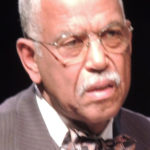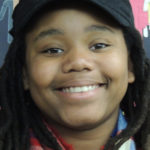By Timothy Bold
The Scene staff
Photography major Kathy Carr had no idea that East St. Louis was the site of bloody race riots in 1917.
“It was horrific, tragic and unthinkable that innocent people were killed for no reason,” she said.
Carr, 46, was one of about 200 people who attended a Jan. 23 program that commemorated the 100th anniversary of the riots.
It was held in the Mildred E. Bastian Center for the Performing Arts at Forest Park, thanks to assistant communications professor Tiffany Lee with help from faculty members Zita Casey and Mariah Richardson and staff member Brittney Aledegbami.
Lee is an East St. Louis native and member of the East St. Louis 1917 Centennial Commission and Cultural Initiative, which co-sponsored the program.
“My purpose was to get students informed on an event that had an effect on both sides of the river,” she said.
The riots occurred on and around July 2, 1917. Labor- and race-related violence left 31 blacks and nine whites dead, according to official records. Some reports put the death toll at closer to 100. More than 300 homes and businesses were burned.
The Forest Park program included speeches, gospel music, a video and spoken word. It was developed by commission members Eugene Redmond and the Rev. Joseph Brown.

“They wanted to assure that students knew the impact (the riots) played, socially and economically,” Lee said.
The keynote speaker was retired St. Clair County Circuit Judge Milton Wharton, commission co-chairman. He provided graphic details of the riots, including blacks being burned alive in buildings guarded by whites with guns.
“Not a whole lot of people (know) about the horrors of the East St. Louis riots,” he said. “Most history books don’t acknowledge this event.”
Also on the program was commission member Karla Scott, dean for diversity and inclusion at St. Louis University. She described the riots as a “pogrom,” defining that as “an organized massacre of a particular group or religion.”

Filmmaker Sandra Pfeifer showed excerpts from “Against All Odds,” her documentary about the riots.
The choir from Truelight Baptist Church in St. Louis sang “Lift Every Voice and Sing,” “God Lead Us Along” and “Every Praise.”
Forest Park students also. Erica Rushing read an original poem, Derrick Owens presented his spoken-word piece “Never Forget I Remember” and Phi Theta Kappa showed its video, “Fire Next Time Rise Above the Flames.”
“I was able to learn history from a perspective of other people,” said audience member Heather Uhuru, 12, a sixth-grader. “I’m feeling more connected. That was never taught in school.”
Also in attendance was Forest Park Provost Larry Johnson. He described the program as “insightful and moving.”
“As I sat in the audience, it reminded me of stories that I taught my students as a professor regarding the South and the struggles of African Americans and other marginalized groups.
“Learning about the struggles of African Americans in the Midwest impressed me in a way like Dr. Martin Luther King Jr.’s ‘urgency of now.’”
The East St. Louis 1917 Centennial Commission and Cultural Initiative is a non-profit organization of community activists, scholars, educators and business and religious leaders. It was formed in 2014 by the city’s mayor and city council.
The next commemorative program will be held on the East St. Louis campus of Southern Illinois University Edwardsville in May.
Such events are designed to “shine light on a tragic event,” said commission co-chairman Edmund Brown.
“My job is to create a real dialogue on race relationships. I want students to understand their history, not only those of color, but as American citizens.
